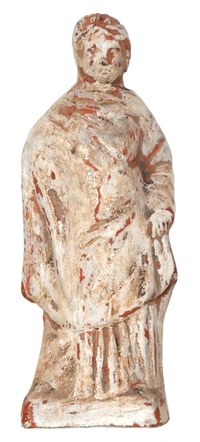Tanagra figurines
 |
 |
|
Female figurine in robe with bow hairstyle, "Tanagra figurine" |
The name is derived from the eponymous site of Tanagra in Boeotia and refers to graceful female terracotta statuettes of the Hellenistic period, which were, however, widespread over almost all Mediterranean regions and beyond[1]. They wear pleasingly draped multi-coloured clothing whose charming painting is often partially preserved, for example when the figures were less exposed to the weather as grave goods, as at Tanagra.
The young women in their elegant robes, their heads protected by a veil or an umbrella-like sun hat, holding mirrors or fans in their hands, belong to an upper bourgeois social class and seem to be about to leave the oikos[2]. Their graceful figures were exactly in line with the taste of the 19th century so that, despite all their efforts, looters and traders could not keep up with the demand. It was a lucrative time for imitators and forgers[3].
The iconography and style of the Tanagra figurines developed in the workshops of Athens, where not only numerous moulds came to light[4], but also the close relations between the large sculptural works of the sculptors of the 4th century BC and the Attic figural vases can be seen[5]. Other notable terracotta workshops were established in Corinth[6] and Macedonia[7]. Thebes and Tanagra had initially imported statuettes from Attica until they began to produce terracottas themselves. Tanagra became an important coroplastic centre, especially after the destruction of Thebes[8].
[1] W. Martini, Sachwörterbuch der Klassischen Archäologie (Stuttgart 2003) 327 f.
[2] G. Zimmer – I. Kriseleit, Bürgerwelten. Hellenistische Tonfiguren und Nachschöpfungen im 19. Jh. Staatliche Museen zu Berlin. Preußischer Kulturbesitz, Antikensammlung (Mainz 1994) 84-87 nos. 1 and 5; V. Jeammet, Tanagra. Mythe et Archéologie (Paris 2003) 177. 195-198 figs. 119. 132 f. L. Burn – R. Higgins, Cat. of Greek Terracottas in the British Museum III (London 2001) 47 no. 2050 pl. 9. 50 no. 2061 pl. 11.
[3] Bürgerwelten 1994, 59-81; Jeammet ibid. 294-305.
[4] L. Frey-Asche, Tonfiguren aus dem Altertum. Antike Terrakotten im Museum für Kunst und Gewerbe (Hamburg 1997) 70
[5] Jeammet ibid. 120-168.
[6] G. S. Merker, Corinth 18, 4 (Princeton 2000) 142 f. no. H 99. H 113 pl. 33 f.
[7] Jeammet ibid. 126 fig. 31.
[8] Jeammet ibid. 126 f.
